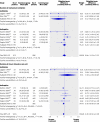Oral decontamination for prevention of pneumonia in mechanically ventilated adults: systematic review and meta-analysis
- PMID: 17387118
- PMCID: PMC1857782
- DOI: 10.1136/bmj.39136.528160.BE
Oral decontamination for prevention of pneumonia in mechanically ventilated adults: systematic review and meta-analysis
Abstract
Objective: To evaluate the effect of oral decontamination on the incidence of ventilator associated pneumonia and mortality in mechanically ventilated adults.
Design: Systematic review and meta-analysis.
Data sources: Medline, Embase, CINAHL, the Cochrane Library, trials registers, reference lists, conference proceedings, and investigators in the specialty.
Review methods: Two independent reviewers screened studies for inclusion, assessed trial quality, and extracted data. Eligible trials were randomised controlled trials enrolling mechanically ventilated adults that compared the effects of daily oral application of antibiotics or antiseptics with no prophylaxis.
Results: 11 trials totalling 3242 patients met the inclusion criteria. Among four trials with 1098 patients, oral application of antibiotics did not significantly reduce the incidence of ventilator associated pneumonia (relative risk 0.69, 95% confidence interval 0.41 to 1.18). In seven trials with 2144 patients, however, oral application of antiseptics significantly reduced the incidence of ventilator associated pneumonia (0.56, 0.39 to 0.81). When the results of the 11 trials were pooled, rates of ventilator associated pneumonia were lower among patients receiving either method of oral decontamination (0.61, 0.45 to 0.82). Mortality was not influenced by prophylaxis with either antibiotics (0.94, 0.73 to 1.21) or antiseptics (0.96, 0.69 to 1.33) nor was duration of mechanical ventilation or stay in the intensive care unit.
Conclusions: Oral decontamination of mechanically ventilated adults using antiseptics is associated with a lower risk of ventilator associated pneumonia. Neither antiseptic nor antibiotic oral decontamination reduced mortality or duration of mechanical ventilation or stay in the intensive care unit.
Conflict of interest statement
Figures





Comment in
-
Preventing ventilator associated pneumonia.BMJ. 2007 Apr 28;334(7599):861-2. doi: 10.1136/bmj.39185.380405.BE. BMJ. 2007. PMID: 17463422 Free PMC article.
References
-
- Chastre J, Fagon JY. Ventilator-associated pneumonia. Am J Respir Crit Care Med 2002;165:867-903. - PubMed
-
- Rello J, Ollendorf DA, Oster G, Vera-Llonch M, Bellm L, Redman R, et al. Epidemiology and outcomes of ventilator-associated pneumonia in a large US database. Chest 2002;122:2115-21. - PubMed
-
- Tablan OC, Anderson LJ, Besser R, Bridges C, Hajjeh R. Guidelines for preventing health-care-associated pneumonia, 2003: recommendations of CDC and the Healthcare Infection Control Practices Advisory Committee. MMWR Recomm Rep 2004;53:1-36. - PubMed
-
- American Thoracic Society, Infectious Diseases Society of America. Guidelines for the management of adults with hospital-acquired, ventilator-associated, and healthcare-associated pneumonia. Am J Respir Crit Care Med 2005;171:388-416. - PubMed
-
- Estes RJ, Meduri GU. The pathogenesis of ventilator-associated pneumonia: I. Mechanisms of bacterial transcolonisation and airway inoculation. Intensive Care Med 1995;21:365-83. - PubMed
Publication types
MeSH terms
Substances
LinkOut - more resources
Full Text Sources
Other Literature Sources
Medical
Miscellaneous
